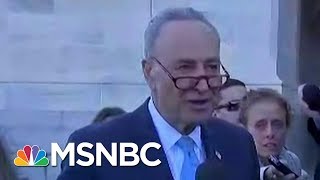Friday, 28 November, 2025г.
















Где искать: по сайтам Запорожской области, статьи, видео ролики
пример: покупка автомобиля в Запорожье
Pelosi, Schumer Blast Trump's Budget That Cuts Social Aid, Boosts Defense Spending
President Donald Trump released his annual budget Monday, proposing deep cuts to social programs but increases in defense and entitlement spending that would push the gross federal debt above $30 trillion over the next decade.
The president’s $4.8 trillion spending plan, posted to the White House’s website Monday afternoon, would increase debt partly because of tax cuts and billions more in spending on defense.
The budget is an election-year embodiment of many of the policy priorities Trump has championed over his first three years in office. Trump proposes continuing his effort to “rebuild” the U.S. military by investing heavily in defense spending -- $740.5 billion in the next fiscal year -- including the creation of Space Force. And the budget for NASA would increase 12% to help underwrite Trump’s proposed manned missions to the Moon and Mars.
“I think people will be very impressed by it,” Trump said at an event Monday morning at the White House. “We’re not touching Medicare, we want to keep Medicare, we’re not touching Social Security, we’re making our country stronger again, we’re not decreasing Medicaid, but we’re doing a lot of things that are very good, including waste and fraud.”
The budget includes significant changes to Medicaid and stringent new work requirements for safety net programs. The president calls for deep cuts to government programs he believes are unpopular with his base, slashing discretionary spending by 5% -- down to $590 billion -- in the coming year. That includes major reductions in foreign aid -- with the State Department and international programs cut 7.7% -- and the Environmental Protection Agency reduced by 26.5% next year.
The annual budget produced by the White House reflects the policy aspirations of the incumbent administration but has no binding power, since federal spending is appropriated by Congress. Lawmakers aren’t expected to finish work on 2021 spending levels until after the November election. And the White House move to change two-year budget cap levels negotiated with Democrats last summer could make an eventual spending deal more difficult.
Democrats quickly took aim at Trump’s proposed cuts. “The budget is a statement of values and once again the President is showing just how little he values the good health, financial security and well-being of hard-working American families,” House Speaker Nancy Pelosi said in a statement Monday.
Trump’s budget shows the president drifting further away from his campaign pledge to eliminate the U.S. national debt by the time he leaves office, even as he envisions discretionary spending shrinking to a mere 1.6% of GDP in 2030 -- about half its current level.
U.S. debt has already risen $3 trillion during Trump’s first three years in office, and his plan calls for adding to the debt until 2035. The $30.5 trillion gross federal debt anticipated by 2030 -- up from $22.7 trillion this fiscal year -- would represent 84.6% of gross domestic product, down from 106.9% this year.
Most Republican presidents have released budgets they say would balance the budget within a decade, though this is the third consecutive plan released by the White House that fails to reach that goal. Only once a budget is in surplus can the underlying debt be paid down.
Still, Trump’s plan cuts spending below current levels, leading the deficit to decline to $966 billion next year and the deficit to shrink to 0.7% of GDP by 2030, according to the White House. That’s below the $1 trillion projected by the nonpartisan Congressional Budget Office under current policies.
Russ Vought, the acting director of Trump’s Office of Management and Budget, blamed Democrats on Capitol Hill for Trump’s inability to balance the budget.
“The Democrats on Capitol Hill have refused to consider the spending reforms the president has put forward,” Vought said Monday in an interview with Bloomberg Television.
The Congressional Budget Office projects that without the policy changes Trump is advocating gross federal debt would rise to $36 trillion in 2030 from $24 trillion in 2020 -- substantially higher than the more than $30 trillion projected by the White House. Debt held by the public would rise from $18 trillion to $31 trillion.
“He now leaves it to future presidents and congresses to achieve fiscal sanity,” said Bill Hoagland, a former Senate budget aide now with the Bipartisan Policy Center.
Subscribe to our YouTube channel: https://bit.ly/2TwO8Gm
QUICKTAKE ON SOCIAL:
Follow QuickTake on Twitter: twitter.com/quicktake
Like QuickTake on Facebook: facebook.com/quicktake
Follow QuickTake on Instagram: instagram.com/quicktake
Subscribe to our newsletter: https://bit.ly/2FJ0oQZ
Email us at [email protected]
QuickTake by Bloomberg is a global news network delivering up-to-the-minute analysis on the biggest news, trends and ideas for a new generation of leaders.
Теги:
chuck schumer nancy pelosi donald trump trump budget student loans student loan forgiveness program border wall breaking news us news domestic news world news happening now new hampshire primary nhprimary nh primary new hampshire democratic presidential candidates defense spending fiscal year latest news u.s. news
Похожие видео
Мой аккаунт


 У вашего броузера проблема в совместимости с HTML5
У вашего броузера проблема в совместимости с HTML5


